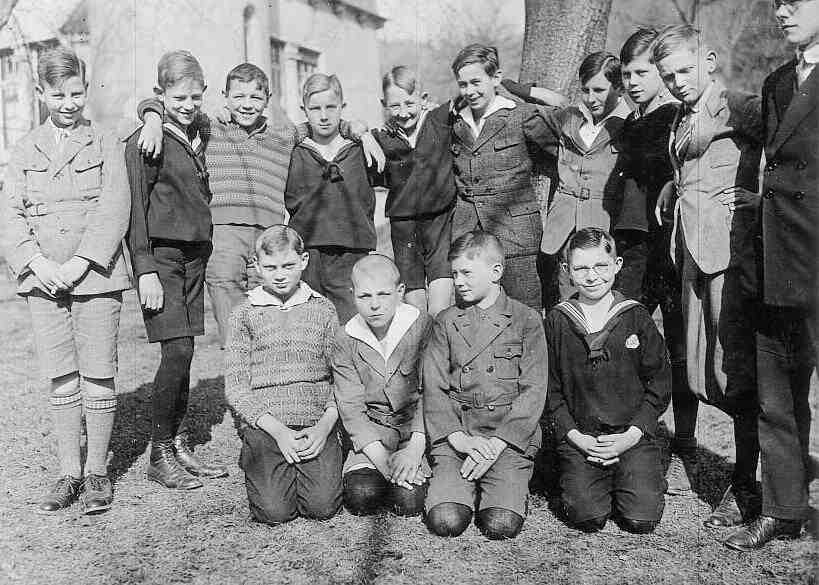
German 20th Century Boys' Hosiery: Chronology: The 1920s

Figure 1.--Here we see a group of German boys. They look to be about 12-13 years old. It may be a school group, but the setting rather suggests one of the outings children took during school vacations. Note the varied outfits and hosiery the boys are wearing, The photograph is undated, but we believe it was taken in the 1920s in part because several boys are wearing black long stockings. A reader writes, "What a lovely happy picture. A group of boys enjoying an outing. A lovely feeling. The boys are clearly good friends. Images like this on HBC really given one an idea as to what boyhood was like in the different periods."
|
|
German hosiery conventions seem rather ill defined in the 1920s and early 30s. We see boys wearing short pants, knee pants, knickers and with different kinds of hosiery. Most boys wore short pants. Teenagers might wear knickers and older teen agers might wear long pants. Knee pants by the 1920s were mostly worn with suits. We see boys commonly wearing both knee socks and long stockings with short pants. Seasonality was a factor, but not the only factor. Family preferences and formality were also factors. Knee socks became increasingly common as the decade progressed, but long stockings were still quite common. We still see mny boys wearing black long stockings, although tan shades had begun to appear by the end of the decade. Long stockings were common with knee pnts suits because of the formality factor. Sailor suits were won with both knee socks and long stockings. Ankle socks were not common. A good example are the brothers in a middle-class family during the 1920s. Another factor was economic conditions. Germany experienced serious economic problems during World War I (1914-18), in large measure because of the Allied blockade. Germany comtinued to have difficult economic problems. This of course affected the children's clothing. In particular we sww many children going barefoot.
Hosiery Types
German hosiery conventions seem rather ill defined in the 1920s and early 30s. We see boys wearing short pants, knee pants, knickers and with different kinds of hosiery. Most boys wore short pants. Teenagers might wear knickers and older teen agers might wear long pants. Knee pants by the 1920s were mostly worn with suits. We see boys commonly wearing both knee socks and long stockings with short pants. Ankle socks were not common.
Seasonality was a factor in the choise of hosiery. It ws not the only factor, bt it certainly was an important fctor. Most German boys in the 1920s wore knee panys or increasingly short pants. They wore these pants year round. Germay is located in central Europe and the winters are quite cold. And most homes were not that well heated so even inside it could be cold. As a result, long stockings were very commonly orn during the inter. We also see knee soks being wrn during the Winter, but long stockings were very common, especially for younger boys. Hosiery was more varied when the weather turned warmer. We still see boys wering three-quater socks, especially for younger boys. Knee socks were more commn in warm weather. Long stockings were still worn by some children. We see long stockings being worn for formal occassions. And some mothers were more insistent about long stockings than others. They were, however, much less common than in the Winter. Some children did not wear hosery in the summer or went barefoot. This seems more common with working-class than middle-class children. We do not note ankle soicks in the 1920s even during the Summer.
Family Preferences
Family preferences and formality were also factors. Some mothers insisted on long stockings more than others. This in part explains why we see some chldren wearing lock sockings even in warm weather.
Fashion Trends
Knee socks became increasingly common as the decade progressed, but long stockings were still quite common.
Colors
We still see many boys wearing black long stockings, although tan shades had begun to appear by the end of the decade.
Formality
Long stockings were common with knee pants suits because of the formality factor. Long stockings were seen my many parents as appropriate when dressing up. This varied from family to family. A good example are the brothers in a middle-class family during the 1920s.
Outfits
Sailor suits were worn with both knee socks and long stockings.
Economic Conditions
Another factor was economic conditions. Germany experienced serious economic problems during World War I (1914-18), in large measure because of the Allied blockade. Germany comtinued to have difficult economic problems affter the War. The economy was disrupted and the political situation furthur disrupted the economy. A run-away inflatin destroyed the life-savings of middle-class Germans. This of course affected the children's clothing. In particular we see many children going barefoot. This was especially common with working-class children.
HBC

Navigate the Boys' Historical Clothing German pages:
[Main German hosiery 20th century chronology page]
[Main German hosiery chronology page]
[German choirs]
[German movies]
[German royalty]
[German school uniforms]
[German youth groups]
[German sailor suits]
[Lederhosen]
[Ethnic]
[Tights]
[Long stockings]
Navigate the Boys' Historical Clothing Web Site:
[Introduction]
[Activities]
[Biographies]
[Chronology]
[Clothing styles]
[Countries]
[Bibliographies]
[Contributions]
[FAQs]
[German glossary]
[Images]
[Links]
[Registration]
[Tools]
[Boys' Clothing Home]
Created: 4:08 AM 1/7/2008
Last updated: 11:14 PM 2/14/2009



